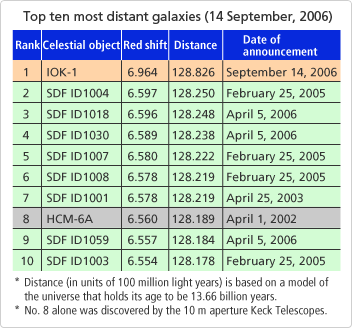Leading the world in the observational study of distant galaxies
As regards the objective of developing FOCAS, what kind of celestial objects is it intended to track down?
It is intended to study distant galaxies. FOCAS was built to show us what the universe looked like at its inception.
The universe began with the Big Bang, and during the first three minutes it expanded enormously. During this period protons and helium nuclei were formed through strong interaction. However, the atomic nuclei of carbon, nitrogen, and oxygen that make up the human body were not formed, since the universe was expanding and the temperature was falling too quickly. Comprised only of hydrogen and helium atoms, the universe continued to expand in this fashion. Approximately 380 thousand years after the Big Bang, the universe cooled down to a temperature of around 3000K, and as a consequence protons and electrons combined to form neutral hydrogen atoms. Since the neutral hydrogen atoms do not interact with photons, they cannot be observed optically today. There are also many aspects of this time that are not understood theoretically, and this is why it is called the Cosmic Dark Ages.

380 thousand years after the Big Bang, the universe was filled with neutral hydrogen atoms. Subsequently the first stars were formed and generated ultraviolet rays. The ionization of the neutral hydrogen atoms enabled them to be observed optically.
After the elapse of several hundred million years, the concentrated neutral atomic hydrogen gas gathered together due to gravity. Within the clouds of collected gas, the first generation of stars were then formed and galaxies were created. Among the stars formed were extremely massive stars that emitted strong ultraviolet rays that heated the intergalactic medium and ionized the neutral hydrogen atoms. This marked the end of the Cosmic Dark Ages and this phenomenon is referred to as the reionization of the universe.
This phenomenon of reionization of the universe is thought to have taken place between approximately 300 million years after the Big Bang (corresponding to a red shift of 14) and approximately 950 million years after the Big Bang (a red shift of 6). However, this is not yet known for certain. When reionized hydrogen gas cools, it emits Lyman alpha photon, a characteristic emission line spectrum in the ultraviolet region with a wavelength of 121.6 nanometers. For this reason, galaxies that have just come into existence and that are continually producing large stars ought to emit strong Lyman alpha photons. The further away a galaxy, the faster it is receding; hence, the wavelengths of the light from it are lengthened, and the above-mentioned Lyman alpha photons undergo a Doppler shift (or red shift) toward longer wavelengths. Ultraviolet radiation will turn into optical wavelengths or even infrared radiation.
In relation to this, the Prime Focus Camera can capture a wide field of view in one shot—something other telescopes cannot do—and by setting a special filter that only admits a narrow wavelength band of infrared radiation, we can search for galaxies that are visible with this filter but not visible or very faint with other filters. This is because such young galaxies emit red-shifted Lyman alpha photons that fall within the wavelength band of the filter. The faint light from these candidate galaxies is then spectroscopically observed over a long exposure time by FOCAS, to ascertain whether this specific light is Lyman alpha emission.
Please tell us about recent topics that involve results from FOCAS.

The top ten most distant galaxies (as of 14 September, 2006). With the exception of No. 8, which was detected by the Keck Telescopes, they were all discovered by the prime-focus camera of the Subaru Telescope and verified using FOCAS.
Given the wide field of view of the Prime Focus Camera and the ability of FOCAS to perform spectroscopy on a larger number of celestial objects within a practical observing time, the Subaru Telescope is a world leader in research fields that involve the observation of distant Universe. Of the top ten most distant galaxies discovered as of July 2007 based on spectroscopic confirmation, discoveries with the Subaru Telescope account for nine of them. Of these, the very furthest galaxy was detected by us. Up until now, many of these galaxies have been referred to by number; however, since this one happened to be the first galaxy whose existence we could verify, we took the liberty of naming it IOK-1, using the initials of the surnames of the people principally involved in its discovery—Iye (me), Ota, and Kashikawa (laughs).

IOK-1, which was detected by Iye, Ota, and Kashikawa. The most distant celestial object (galaxy).
Up until now, distant galaxies that have been detected have exhibited a red shift of 6.6. However, IOK-1 exhibits a red shift of approximately 7.0, by far the highest recorded so far. The detection of distant galaxies is absorbing enough in itself; however, as it takes a long time for the light from distant galaxies to reach earth, even more exciting is the fact that distant galaxies also represent the face of ancient galaxies. Going back a further 60 million years or so, before the records that have been compiled using Subaru, the records for IOK-1 make it possible to see whether or not cosmic reionization had finished in this period. If we conduct further research into this period, we will be able to see the state of affairs at the time that the first stars came into existence and the universe was being heated up.

